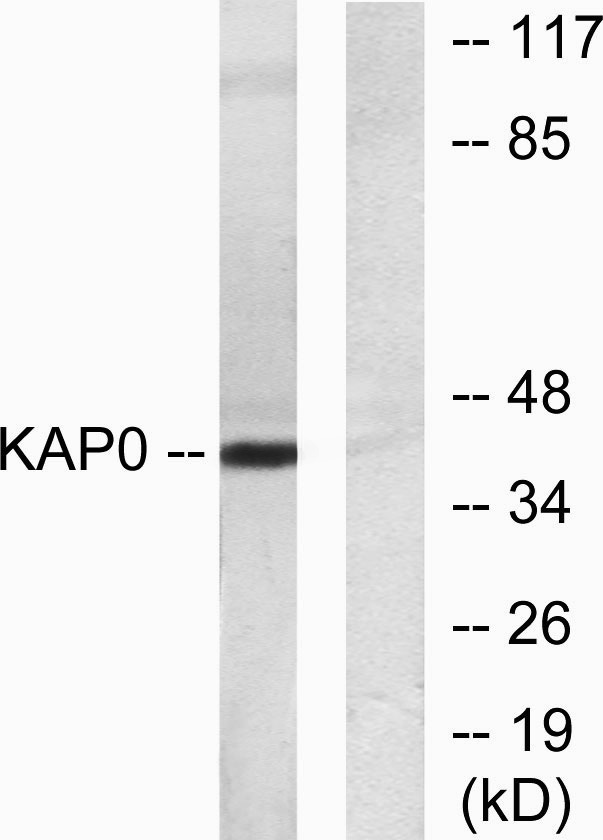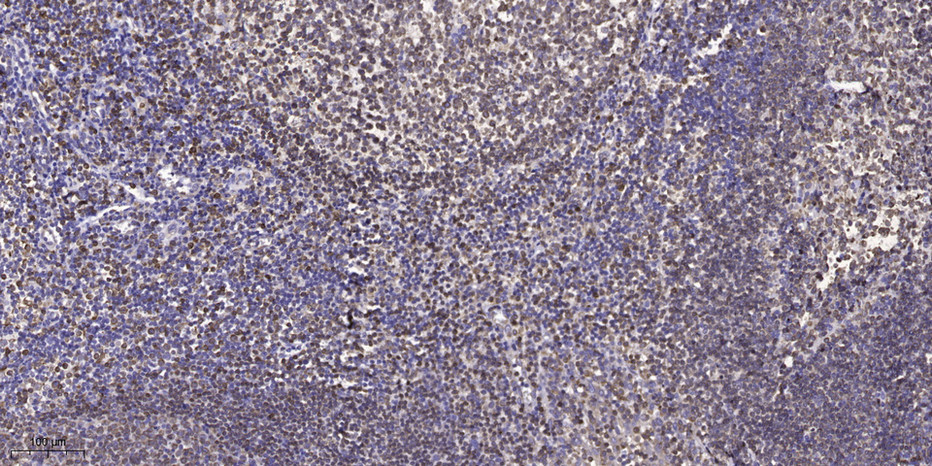PKA Iα reg Polyclonal Antibody
- Catalog No.:YT3746
- Applications:WB;IHC;IF;ELISA
- Reactivity:Human;Mouse;Rat
- Target:
- PKA Iα reg
- Fields:
- >>Insulin signaling pathway
- Gene Name:
- PRKAR1A
- Protein Name:
- cAMP-dependent protein kinase type I-alpha regulatory subunit
- Human Gene Id:
- 5573
- Human Swiss Prot No:
- P10644
- Mouse Gene Id:
- 19084
- Mouse Swiss Prot No:
- Q9DBC7
- Rat Gene Id:
- 25725
- Rat Swiss Prot No:
- P09456
- Immunogen:
- The antiserum was produced against synthesized peptide derived from human KAP0. AA range:271-320
- Specificity:
- PKA Iα reg Polyclonal Antibody detects endogenous levels of PKA Iα reg protein.
- Formulation:
- Liquid in PBS containing 50% glycerol, 0.5% BSA and 0.02% sodium azide.
- Source:
- Polyclonal, Rabbit,IgG
- Dilution:
- WB 1:500 - 1:2000. IHC 1:100 - 1:300. IF 1:200 - 1:1000. ELISA: 1:20000. Not yet tested in other applications.
- Purification:
- The antibody was affinity-purified from rabbit antiserum by affinity-chromatography using epitope-specific immunogen.
- Concentration:
- 1 mg/ml
- Storage Stability:
- -15°C to -25°C/1 year(Do not lower than -25°C)
- Other Name:
- PRKAR1A;PKR1;PRKAR1;TSE1;cAMP-dependent protein kinase type I-alpha regulatory subunit;Tissue-specific extinguisher 1;TSE1
- Observed Band(KD):
- 43kD
- Background:
- cAMP is a signaling molecule important for a variety of cellular functions. cAMP exerts its effects by activating the cAMP-dependent protein kinase, which transduces the signal through phosphorylation of different target proteins. The inactive kinase holoenzyme is a tetramer composed of two regulatory and two catalytic subunits. cAMP causes the dissociation of the inactive holoenzyme into a dimer of regulatory subunits bound to four cAMP and two free monomeric catalytic subunits. Four different regulatory subunits and three catalytic subunits have been identified in humans. This gene encodes one of the regulatory subunits. This protein was found to be a tissue-specific extinguisher that down-regulates the expression of seven liver genes in hepatoma x fibroblast hybrids. Mutations in this gene cause Carney complex (CNC). This gene can fuse to the RET protooncog
- Function:
- disease:Defects in PRKAR1A are the cause of Carney complex type 1 (CNC1) [MIM:160980]. CNC is a multiple neoplasia syndrome characterized by spotty skin pigmentation, cardiac and other myxomas, endocrine tumors, and psammomatous melanotic schwannomas.,disease:Defects in PRKAR1A are the cause of intracardiac myxoma [MIM:255960]. Inheritance is autosomal recessive.,disease:Defects in PRKAR1A are the cause of primary pigmented nodular adrenocortical disease type 1 (PPNAD1) [MIM:610489]. Primary pigmented nodular adrenocortical disease is a rare bilateral adrenal defect causing ACTH-independent Cushing syndrome. Macroscopic appearance of the adrenals is characteristic with small pigmented micronodules observed in the cortex. PPNAD1 is most often diagnosed in patients with Carney complex, but it can also be observed in patients without other manifestations or familial history.,PTM:The pseudop
- Subcellular Location:
- Cell membrane .
- Expression:
- Four types of regulatory chains are found: I-alpha, I-beta, II-alpha, and II-beta. Their expression varies among tissues and is in some cases constitutive and in others inducible.
- June 19-2018
- WESTERN IMMUNOBLOTTING PROTOCOL
- June 19-2018
- IMMUNOHISTOCHEMISTRY-PARAFFIN PROTOCOL
- June 19-2018
- IMMUNOFLUORESCENCE PROTOCOL
- September 08-2020
- FLOW-CYTOMEYRT-PROTOCOL
- May 20-2022
- Cell-Based ELISA│解您多样本WB检测之困扰
- July 13-2018
- CELL-BASED-ELISA-PROTOCOL-FOR-ACETYL-PROTEIN
- July 13-2018
- CELL-BASED-ELISA-PROTOCOL-FOR-PHOSPHO-PROTEIN
- July 13-2018
- Antibody-FAQs
- Products Images

- Western Blot analysis of various cells using PKA Iα reg Polyclonal Antibody
.jpg)
- Western Blot analysis of 293 cells using PKA Iα reg Polyclonal Antibody

- Western blot analysis of lysates from HepG2 cells, using KAP0 Antibody. The lane on the right is blocked with the synthesized peptide.

- Immunohistochemical analysis of paraffin-embedded human tonsil. 1, Antibody was diluted at 1:200(4° overnight). 2, Tris-EDTA,pH9.0 was used for antigen retrieval. 3,Secondary antibody was diluted at 1:200(room temperature, 45min).


